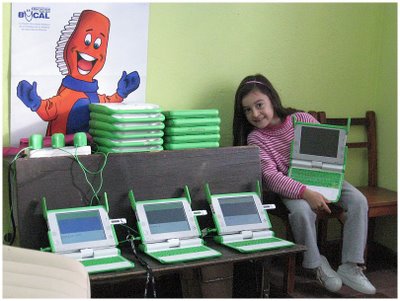It has been a long journey for Uruguay's grand project to put a laptop in the hand of every student, Plan CEIBAL (Project of Educational Connectivity of Basic Information for Online Learning). Uruguay was the first national government to commit to the controversial One Laptop Per Child project, borne out of MIT's Media Lab.

In a 2007 academic paper reflecting on the first phase of the OLPC deployment in Uruguay, Juan Pablo Hourcade, Daiana Beitler, Fernando Cormenzana, and Pablo Flores write:
The increasing digital divide between those in developed and developing regions of the world has the potential of increasing the economic gap between these regions. The One Laptop Per Child (OLPC) Foundation has championed the idea of providing every child in developing regions with a laptop in order to address this problem. The idea is that by providing children with computer and information resources, they will be better prepared to compete in the global economy through computer and information literacy as well as a wider world view …
… overall, we found that in spite of several problems with connectivity, malfunctioning input devices, and software not designed taking into account young children’s abilities or the need for localization, the laptops so far had a very positive impact. Children are motivated to read and write more using the laptops, they are accessing information resources that are far beyond what was previously available to them, they are creating content for the world to see, and collaborating and learning from each other.
There are several obstacles, however, standing in the way of participatory, networked education. First, it is an election year in Uruguay and, as Yama Ploskonka points out, President Vásquez is eager to paint Project Ceibal in favorable light as he heads out of office, while opposition candidates are quick to criticize the program as having a large budget and small impact. But it is the national telco monopoly ANTEL who has the most to lose if internet access is given freely to schools and students, as was originally proposed.

Countering Ploskonko's criticisms, however, Miguel Brechner of Project Ceibal says the government has reached an agreement with ANTEL for a special rate of $8 a month for families with students. By the end of the year he claims that 380,000 laptops will have been deployed in 2,000 schools, and that Montevideo will have 350 wi-fi hotspots where students can connect to the net.
The first two years of Project Ceibal have been characterized by implementation and incubation. The laptops have been deployed to schools, manuals have been created, tech savvy volunteer groups have been formed, wireless internet connections have been established, teachers have slowly learned how to implement the laptops into their curricula and classrooms, and, as Rezwan has covered previously, a community of open source programmers have developed educational applications for the laptops.

One of those applications is Edublog, a customized blogging tool for the XO laptops. Already a number of teachers with laptops in their classrooms are using blogs to publish information about their classes. However, publishing to a Blogspot- or WordPress-based blog from an XO laptop has proven to be difficult. A wiki page describing the architecture of the system explains:
Blogs are an excellent educational tool as demonstrated by the use of Google Blogger in Villa Cardal, Uruguay. The kids had some issues and requested changes to make the system easier to use. Setting up the system on the XO was difficult due to Blogger's many features and bandwidth intensive resources. Technicians needed to assist in actually posting the blog entries to the internet. Very few (if any) current blogging systems are easy enough for use by young children in the low bandwidth environment they have in third world countries. The Educational Blogger Project will address these problems. Essentially, it stores posts locally using Moodle (or similar service) and allows for kids to collaborate, gives teachers the control they need and optimizes the process for the XO environment. It also allows teachers to release posts to Google Blogger, WordPress or other blogging systems. The Educational Blogger Project significantly facilitates the use of blogs on the XO environment and makes it available for more widespread use. The ultimate goal is to create an system that can be set up easily on any XO and used by kids around the world.

You can see one such sample blog by Nati from Peñarol.
Beginning in June, Flores, along with a number of students from the University of Uruguay will organize a series of workshops in Montevideo and around the country to teach young students with XO laptops how to set up their own digital space on Edublogs where they can post stories, opinions, photos, and video.
I am sure that everyone who has worked on the One Laptop Per Child deployment in Uruguay will readily admit that it hasn't been an easy road, but the necessary infrastructure and community now exist for Uruguayan youth to take hold of their own educational and media futures.




10 comments
Inspiring story. I just posted a snip from it at my blog:
http://lougold.blogspot.com/2009/05/digital-revolution-in-south-america.html
All the best for happy blogging,
lou
Thanks for the post David, it’s a good description of what’s happening in my country.
I’d like to remark that the first quotation refers to an article we wrote in late 2007, when the only deployment was in Villa Cardal, and software was very different from how it’s now. Now we have other challenges I’m hopeful to have time to write about soon.
Regards,
Pablo Flores
Thank you! I added a link to the Uruguayan paper in laptop.org ‘Academic Papers’ wiki page.
http://wiki.laptop.org/go/Academic_papers
This is a great thing the UY government is doing. Learning how to blog at a young age could very well translate into a successful eBusiness in the future.